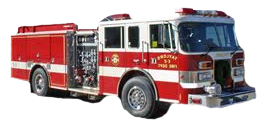Fire Safety – December Holiday and Christmas Tree
CHRISTMAS TREE SAFETY TIPS | DECEMBER HOLIDAY SAFETY
CHRISTMAS TREE SAFETY TIPS
 Each year, fire departments respond to an average of 210 structure fires caused by Christmas trees. Carefully decorating Christmas trees can help make your holidays safer.
Each year, fire departments respond to an average of 210 structure fires caused by Christmas trees. Carefully decorating Christmas trees can help make your holidays safer.
Picking the tree
- If you have an artificial tree, be sure it is labeled, certified, or identified by the manufacturer as fire-retardant.
- Choose a tree with fresh, green needles that do not fall off when touched.
Placing the tree
- Before placing the tree in the stand, cut 1″ – 2″ from the base of the trunk.
- Make sure the tree is at least three feet away from any heat source, like fireplaces, radiators, candles, heat vents or lights.
- Make sure the tree is not blocking an exit.
- Add water to the tree stand. Be sure to add water daily.
Lighting the tree
- Use lights that have the label of an independent testing laboratory. Some lights are only for indoor or outdoor use, but not both.
- Replace any string of lights with worn or broken cords or loose bulb connections. Connect no more than three strands of mini string sets and a maximum of 50 bulbs for screw-in bulbs. Read manufacturer’s instructions for the number of LED strands to connect.
- Never use lit candles to decorate the tree.
- Always turn off Christmas tree lights before leaving home or going to bed.
After Christmas
- Get rid of the tree when it begins dropping needles. Dried-out trees are a fire danger and should not be left in the home or garage, or placed outside against the home. Check with your local community to find a recycling program. Bring outdoor electrical lights inside after the holidays to prevent hazards and make them last longer.
Click here for a printable version.
Facts & figures
- Between 2007-2011, U.S. fire departments responded to an average of 230 home fires that started with Christmas trees per year. These fires caused an average of 6 deaths, 22 injuries, and $18.3 million in direct property damage annually.
- On average, one of every 40 reported home fires that began with a Christmas tree resulted in a death, compared to an average of one death per 142 total reported home fires.
- Electrical problems resulted in one-third (32%0 of home Christmas tree structure fires.
- Two of every five (39%) home Christmas tree fires started in the living room, family room, or den.
Source: NFPA’s “Home Christmas Tree and Holiday Light Fires” by John R. Hall, Jr., November 2013.
Home Christmas Tree Fires Fact Sheet –
Click here for a printable PDF version.
Click here for more information about holiday safety.
Video: This NFPA/UL video demonstrates the flammability of a dry Christmas tree vs. a tree that has been watered regularly.
Video:NFPA’s Lisa Braxton offers a few simple safety tips to consider during the holiday season.
This test was conducted by the National Fire Protection Association and Underwriters Laboratories. For more information: http://www.nfpa.org/categoryList.asp?…
HOLIDAY SAFETY
Winter holiday fires by the numbers
- Electrical distribution or lighting equipment was involved in 35% of home Christmas tree fires.
- One-fifth (20%) of the decoration fires started in the kitchen. One out of six (17%) started in the living room, family room or den.
- The top three days for home candle fires were Christmas, New Year’s Day, and Christmas Eve.
View Winter_Holiday_Safety Tips – Printable.




